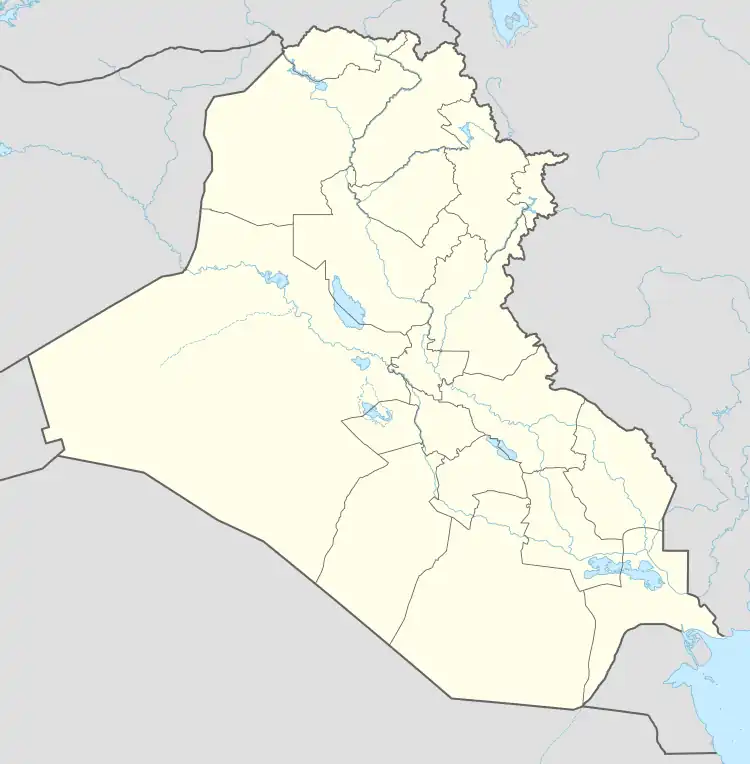Ubaydah Bin Al Jarrah Air Base
Ubaydah Bin Al Jarrah Air Base (al-Kut Air base) is an Iraqi Army Aviation Corps base near Kut, Wasit Governorate, Iraq. It was captured by U.S.-led Coalition forces during Operation Iraqi Freedom in 2003.
| Ubaydah Bin Al Jarrah Air Base (al-Kut Air base) FOB Delta  | |||||||||
|---|---|---|---|---|---|---|---|---|---|
| Near Kut, Wasit Governorate in Iraq | |||||||||
 Ubaydah Bin Al Jarrah Air Base Shown within Iraq | |||||||||
| Coordinates | 32°29′01″N 045°45′21″E | ||||||||
| Site information | |||||||||
| Owner | Ministry of Defence | ||||||||
| Operator | Iraqi Air Force 1973-2003 United States Army 2003-2011 Iraqi Army Aviation Corps 2012—Present | ||||||||
| Site history | |||||||||
| Built | 1973 | ||||||||
| In use | 1973–present | ||||||||
| Airfield information | |||||||||
| Identifiers | IATA: ORUB | ||||||||
| Elevation | 130 metres (427 ft) AMSL | ||||||||
| |||||||||
History
Ubaydah Bin Al Jarrah Air Base was one of several Iraqi Air Force airfields in the mid-1970s which were re-built under project "Super-Base" in response to the experiences from Arab-Israeli wars in 1967 and 1973.
Originally, 13 airfields were re-built by British contractors, and on all of them also a number of hardened aircraft shelters was built. Subsequently, companies from Yugoslavia – previously engaged in building bridges in Iraq – became involved. Due to their specific construction of these airfields - which included taxi-ways leading right out of Hardened Aircraft Shelters (HAS) and laid diagonally to the runways - they became known as "Trapezoids" or "Yugos".
The facilities were divided into two categories: "surface" and "underground". The "surface" facilities were actually the "softest", and included maintenance hangars of metal construction, and HAS of concrete construction. In total, the Yugoslavs have built no less but 200 HAS on different airfields in Iraq during the 1980s.
The protection of each HAS consisted of one-metre-thick concrete shells, reinforced by 30 cm thick steel plates. There was only one entrance and this was covered by sliding doors, made of 50-cm-thick steel armoured plate and concrete. The HAS' were usually built in small groups, seldom more than five, with each group sharing the same water and power supply, besides having own backup gasoline-powered electrical generator, and each HAS being equipped with a semi-automatic aircraft-refuelling system.
In addition, underground facilities that could shelter between four and ten aircraft on average were constructed. In order to build these, the Yugoslavs used equipment and construction techniques identical to that use in underground oil-storage depots, additionally concealing the extension and the true purpose of the whole project. The underground facilities were all hardened to withstand a direct hit by a tactical nuclear bomb, buried up to 50 meters below the ground and consisted of the main aircraft "hangar" (consisting of two floors in several cases, connected by 40ts hydraulic lifts), connected with operations, maintenance, and logistical facilities via a net of underground corridors.
Under Iraqi Air Force control, this was a base for a full wing with three squadrons of Su-20/22s and a squadron of MiG-21s or MiG-23s for air defence. It was heavily hit by the RAF in 1991 during Operation Desert Storm, but was repaired subsequently and it remained a Su-22 base in the 1990s as well.
It was relatively undamaged despite additional hits during Operation Desert Storm and Operation Iraqi Freedom.
Modern Era - U.S. invasion and occupation
The base was abandoned by Iraqi forces and was used by United States Army after its seizure. During U.S. occupation, the air base was known as Forward Operating Base Delta[1] and Camp Delta[2] During 2011 it was known as Contingency Operating Base Delta[3]
During 2008, it was home to troops from the United States, Poland, Lithuania, Georgia, El Salvador, Kazakhstan and Romania. During 2009, it was home to the 41st Fires Brigade[1][4] until August 2009 when 1st Battalion, 77th Field Artillery Regiment took over.[5]
From June 2011 the base was home to 6th ‘Saber’ Squadron, 9th Cavalry Regiment, 3rd Advise and Assist Brigade, 1st Cavalry Division, United States Division – South[3] until October 2011.[6][7]
The base personnel were also supported from personnel from other bases.[8]
Return to Iraqi Control
Current aerial photography shows many abandoned buildings on the former air base, however, the runway and taxiways are intact with a standing hangar on one of the parking areas. Helicopters can be seen in a dispersal area in addition to numerous vehicles and conex boxes. Beginning in 2015, the base was used to launch drone strikes on ISIS targets.[9]
According to Scramble.nl the base is now used by the Iraqi Army Aviation Corps[10]
References
![]() This article incorporates public domain material from the Air Force Historical Research Agency.
This article incorporates public domain material from the Air Force Historical Research Agency.
- "FOB Delta not just enduring – it's growing". Stars and Stripes. Retrieved November 21, 2020.
- "THE U.S. ARMY In The 2007-2011 Volume 2 Iraq Warsurge And Withdrawal - Map 5. Operation IRAQI FREEDOM, Major Camps, 2003–2011 - pg Appendix V" (PDF). U.S. Army War College. Retrieved November 21, 2020.
- "Saber Squadron arrives at COB Delta". DVIDS. Retrieved November 21, 2020.
- "FOB Delta preps for emergencies". US Army. Retrieved November 21, 2020.
- "Welcome home 172nd Infantry Brigade: 1-77 brought the big guns, but rarely fired them". Retrieved November 21, 2020.
- "Last brigade leaves Iraq". US Army. Retrieved November 21, 2020.
- "THE U.S. ARMY In The 2007-2011 Volume 2 Iraq Warsurge And Withdrawal - Chart 1. U.S. Military Base Closures (December 2010-December 2011). - pg 594" (PDF). U.S. Army War College. Retrieved November 21, 2020.
- "The Front Line: Capt. Tom Auers". USAF. Retrieved November 21, 2020.
- "Iraq launches its first drone from Kut Airbase to target ISIS sites in Anbar". Iraqi News. Retrieved November 21, 2020.
- "Orbats - Al Kut/Ubaydah Bin Al Jarrah (ORUB)". Scramble.nl. Retrieved November 21, 2020.